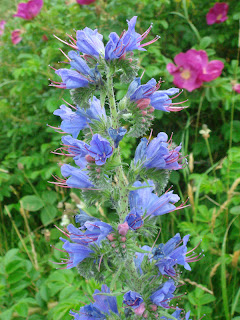Thursday,June 28th
A warm day and so I decided to go for a walk along the beach. To my surprise
there were very few people around. I could even park in the small free car
park, only a short walk through the dunes to the beach. The abundance of
flowering shrubs and plants amazed me. Dunes are just sand hills, no fertile or
rich soil. But the path on both sides was laced with fragrant roses, a special
species which so far I have only found in the dunes. In contrast to garden
roses which need to be pampered, watered and fertilised, these roses seem to
need next to nothing and flower all summer. They have a single row of petals,
saffron yellow hearts, and are either white or pink in colour. Together with
the porcelain blue flowers of the Echium Vulgare (in Dutch: Slangenkruid, Blueweed in English ), and the yellow flowering Jacobeae Vulgaris or Ragwort they provided a feast
of subtle colour to the usual silvergrey shades of this coastal landscape.
Probably our wet spring had something to do with it.
It was warm,
but overcast and very humid. The beach had this mysterious air, the villages to
the north and the south hardly visible through the haze. The weather forecast
was for thunderstorms in the afternoon, high winds, hailstones and rain. So I set off in the morning. Fortunately, as the tide was just going out,
I could walk on very firm sand, as yet totally untouched: no footprints at all,
except for the webbed prints of seagulls which forage on the edge of the water looking
for mussels and clams or other small sea food. Once walking away from the Wassenaar,
I hardly met anybody. The water was clean and crystal clear, but still very
cold, only 13 degrees I was told, for me just about right to dip my toes in and
cool my feet.
It was exhilarating, the feeling of having this vast empty space
with a wide horizon all to myself. The sound of the breaking waves and the
cries of the sea birds made thinking impossible and chased away any anxieties
or nagging thoughts. It was an added joy to find a perfectly formed and
undamaged shell, a very rare find on the beaches along this coast. I have
always lived on the North sea coast, but this was the first time I found a
shell like that. There might be more, for when after a brisk walk of an hour I
retraced my steps, a tractor with a net attached to it was scooping up banks of
shells out of the water and placing them on the hard sand in ever growing
heaps. They were loaded into a truck later, so I don't know what hidden
treasures, if any, were carted off among that load of common shells.





This new beach walk reminds me of untracked snow in the mountains as you ski silently in the heavy forest.
ReplyDeleteAny idea what the shells are used for? Cement perhaps?
HAve you walked the beaches of northern California and Oregon. You will find such incredible treasures. The grandkids once found a sea lion pup placed there by its mom while she went on a feeding tour. You could get right up to the pup and almost touch it but it made a hissing sound to make sure you stayed a safe distance away. By the next morning, it was gone. Apparently, this is a common behavior of this animal.
Shells are used for paths. They are crushed first of course.
ReplyDeleteI have walked the beaches on the Outer Banks in North Colorado. We once had a two week holiday in a beach house - on stilts -, and near San Francisco. Yes, on the Outer Banks I found huge shells and on the West Coast sea lions. But on our north sea coast any such finds are unusual and rare. Except for sea lions which one finds in abundance in the north on the beaches and the sand banks between the Wadden Islands.